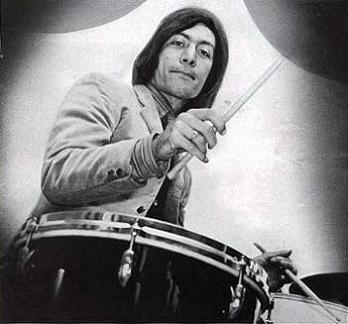
 : : Great drummers
: : Great drummers
- Acuña Alex
- Agostini Dante
- Alexander Tim "Herb"
- Allen Tony
- Ameen Robby
- Appice Carmine
- Aronoff Kenny
- Arpino Thierry
- Barretto Ray
- Belleville Pierre
- Bellson Louie
- Bissonette Gregg
- Blackwell Ed
- Blaine Hal
- Blakey Art
- Bonham John
- Bozzio Terry
- Brown Carlinhos
- Brown Gerry
- Bruford Bill
- Carrington Terri Lyne
- Ceccarelli André
- Cerrone Marc
- Chambers Dennis
- Cinelu Mino
- Clarke Kenny
- Cobham Billy
- Colaiuta Vinnie
- Collins Phil
- Conte Luis
- Copeland Stewart
- Da Fonseca Duduka
- de Grasso Jimmy
- de Johnette Jack
- Diabaté Inza
- Diaz Miguel "Anga"
- Dodds Warren "Baby"
- Donati Virgil
- Dunbar Lowell “Sly”
- Erbetta Marc
- Erskine Peter
- Escovedo Sheila "E"
- Ewandé Louis César
- Fanfant Jean-Philippe
- Foster Al
- Gadd Steve
- Garibaldi David
- Gastaldin Claude
- Gonzalez Jerry
- Gozzo Alain
- Greer Sonny
- Grohl Dave
- Guem
- Gurtu Trilok
- Gustke Ralf
- Hakim Omar
- Haynes Roy
- Hernandez “El Negro” Horacio
- Hidalgo Giovanni
- Higgins Billy
- Hoglan Gene
- Humair Daniel
- Hussain Zakir
- Jacquin Jean-Christophe
- Jimbo Akira
- Jones Elvin
- Jones "Philly" Joe
- Jones « Papa » Jo
- Jordison Joey
- Katché Manu
- Keita Mamady
- Kolinka Richard
- Krupa Gene
- Lake JR Oliver Gene
- Lang Thomas
- Latham Rick
- Mac Brain Nicko
- Mason Harvey
- Mattalia Alessia
- Mayer Jojo
- Michelino Silvano
- Minnemann Marco
- Mitchell John "Mitch"
- Mocidade Independente de Padre Miguel
- Moeller Sanford
- Moreira Airto
- Morello Joe
- N'Diaye Rose Doudou
- Oxley Tony
- Paice Ian
- Paolini Jean-Claude
- Parker Leon
- Peart Neil
- Phillips Simon
- Poleo Orlando
- Porcaro Jeff
- Portnoy Mike
- Pozo Chano
- Priester Aquiles
- Puente Ernesto « Tito »
- Purdie Bernard "Pretty"
- Quintana Jose Luis "Changuito"
- Rekow Raul
- Renaudin Bertrand
- Rich Buddy
- Roach Max
- Roddy Derek
- Samba Mokhtar
- Sanchez Poncho
- Santamaria Mongo
- Séry Paco
- Smith Chad
- Smith Marvin “Smitty”
- Smith Steve
- Sorum Matt
- Starr Ringo
- Stewart Bill
- Stubblefield Clyde
- Temiz Okay
- Terrana Mike
- Top Secret Drum Corps Basel Suisse
- Ulrich Lars
- Vander Christian
- Wassy Brice
- Watts Charlie
- Watts Jeff
- Webb Chick
- Weckl Dave
- White Lenny
- Wilk Brad
- Williams Tony
- Ziad Karim
Watts Charlie
Musicians or bands:
The Rolling Stones
Biography and commentary:

Charlie Watts is the Rolling Stones drummer (born in 1941 in England, dead in 2021) almost since their beginnings (which proves that his playing is inseparable from the sound of the group), from jazz training (and professional advertising designer in his beginnings), the oldest member of the group and one of the first pop-rock drummers (and even funk and disco). Unlike most rock drummers, he favors efficiency and stoicism on rough and "messy" playing (an opposition interesting to note in relation to Mick Jagger, who is really a son of R'N'B and inspirer of hard rock). With the Beatles, the Rolling Stones were among the first bands of English rock'n roll (first group: 1962, joining of Charlie in the band: 1963, debut album: "The Rolling Stones", 1964). Charlie Watts is one of the first drummers (with Bernard Purdie, a specialist in the mixing of blues, jazz, funk and rock as well) to play rock in "double swing" (decomposition of each time in 9 equal beats (triplets of eighth-note triplets) on the song "Time is on my side" (which was played for the first time in big band but in 3/4 swung by the orchestra of Kai Winding in 1963 and covered in song the same year as the Stones (1964) by soul singer Irma Thomas). This type of accompanying rhythms is for me a kind of peak of sophistication of blues and rock, which represents well the demanding, the avant-garde and culture that may have the Stones since their early days (even if they content themselves here just with following the vanguard of the American R & B), and explains the popular impact (first single of the Stones in the top ten of the US charts, the Rolling Stones have now sold over 200 million albums), far from the stereotypes of some historians who amalgamate in general the popular success to simplism. The performance of Charlie on "Stray Cat Blues" (1968) is very close to the disco style (Marc Cerrone) before the letter. Though always partly improvised, many songs have specific mnemonic details, a trademark of the British pop music, like the Beatles, principle since used by everyone in “variety” music. The use of breaks beats (example: "Gimme Shelter" on "Let It Bleed", 1969), ghost notes and rolls (tras, ras), is not without reminding of the funk of Clyde Stubblefield (James Brown). Charlie is capable to play a subtle swing between binary and ternary (typical of folk-blues, of Ringo Starr, Bernard Purdie and Steve Gadd). The passion for jazz of Charlie never left him, it is attested by his album "Flight to Sidney", in 1986, alongside Elvin Jones and Lee Konitz or "From One Charlie", a tribute to the saxophonist Charlie Parker (1993) or also recently "Live at Scott's" (2004), which brilliantly mixes various musical influences, but completely instrumental and acoustic.
Marc De Douvan, publication in French: January 3, 2006 (for the translation in English: July 12, 2015; updated on August 26, 2021)
Official website
SeeLink to Drummerworld or other
See© 2005 Marc de Douvan Crédits Mentions légales
